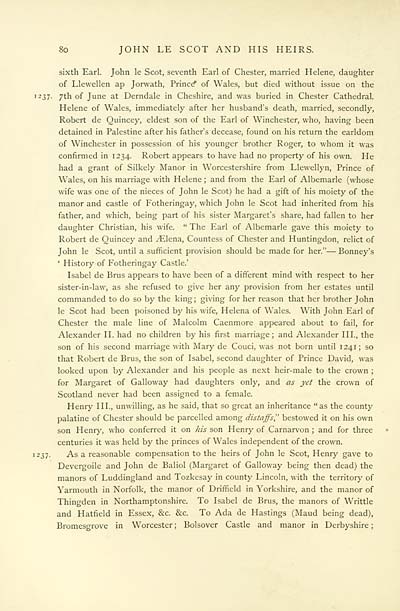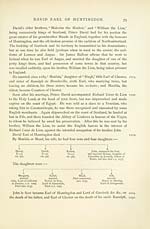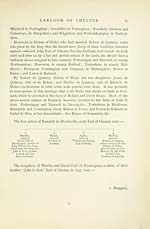Family records of the Bruces and the Cumyns
(92) Page 80
Download files
Complete book:
Individual page:
Thumbnail gallery: Grid view | List view

So JOHN LE SCOT AND HIS HEIRS.
sixth Earl. John le Scot, seventh Earl of Chester, married Helene, daughter
of Llewellen ap Jorwath, Prince* of Wales, but died without issue on the
1237. 7th of June at Derndale in Cheshire, and was buried in Chester Cathedral.
Helene of Wales, immediately after her husband's death, married, secondly,
Robert de Ouincey, eldest son of the Earl of Winchester, who, having been
detained in Palestine after his father's decease, found on his return the earldom
of Winchester in possession of his younger brother Roger, to whom it was
confirmed in 1234. Robert appears to have had no property of his own. He
had a grant of Silkely Manor in Worcestershire from Llewellyn, Prince of
Wales, on his marriage with Helene ; and from the Earl of Albemarle (whose
wife was one of the nieces of John le Scot) he had a gift of his moiety of the
manor and castle of Fotheringay, which John le Scot had inherited from his
father, and which, being part of his sister Margaret's share, had fallen to her
daughter Christian, his wife. " The Earl of Albemarle gave this moiety to
Robert de Quincey and ^Elena, Countess of Chester and Huntingdon, relict of
John le Scot, until a sufficient provision should be made for her." — Bonney's
' History of Fotheringay Castle.'
Isabel de Brus appears to have been of a different mind with respect to her
sister-in-law, as she refused to give her any provision from her estates until
commanded to do so by the king; giving for her reason that her brother John
le Scot had been poisoned by his wife, Helena of Wales. With John Earl of
Chester the male line of Malcolm Caenmore appeared about to fail, for
Alexander II. had no children by his first marriage ; and Alexander III., the
son of his second marriage with Mary de Couci, was not born until 1241 ; so
that Robert de Brus, the son of Isabel, second daughter of Prince David, was
looked upon by Alexander and his people as next heir-male to the crown ;
for Margaret of Galloway had daughters only, and as yet the crown of
Scotland never had been assigned to a female.
Henry III., unwilling, as he said, that so great an inheritance "as the county
palatine of Chester should be parcelled among distaffs" bestowed it on his own
son Henry, who conferred it on his son Henry of Carnarvon ; and for three
centuries it was held by the princes of Wales independent of the crown.
1237. As a reasonable compensation to the heirs of John le Scot, Henry gave to
Devergoile and John de Baliol (Margaret of Galloway being then dead) the
manors of Luddingland and Tozkesay in county Lincoln, with the territory of
Yarmouth in Norfolk, the manor of Driffield in Yorkshire, and the manor of
Thingden in Northamptonshire. To Isabel de Brus, the manors of Writtle
and Hatfield in Essex, &c. &c. To Ada de Hastings (Maud being dead),
Bromesgrove in Worcester; Bolsover Castle and manor in Derbyshire;
sixth Earl. John le Scot, seventh Earl of Chester, married Helene, daughter
of Llewellen ap Jorwath, Prince* of Wales, but died without issue on the
1237. 7th of June at Derndale in Cheshire, and was buried in Chester Cathedral.
Helene of Wales, immediately after her husband's death, married, secondly,
Robert de Ouincey, eldest son of the Earl of Winchester, who, having been
detained in Palestine after his father's decease, found on his return the earldom
of Winchester in possession of his younger brother Roger, to whom it was
confirmed in 1234. Robert appears to have had no property of his own. He
had a grant of Silkely Manor in Worcestershire from Llewellyn, Prince of
Wales, on his marriage with Helene ; and from the Earl of Albemarle (whose
wife was one of the nieces of John le Scot) he had a gift of his moiety of the
manor and castle of Fotheringay, which John le Scot had inherited from his
father, and which, being part of his sister Margaret's share, had fallen to her
daughter Christian, his wife. " The Earl of Albemarle gave this moiety to
Robert de Quincey and ^Elena, Countess of Chester and Huntingdon, relict of
John le Scot, until a sufficient provision should be made for her." — Bonney's
' History of Fotheringay Castle.'
Isabel de Brus appears to have been of a different mind with respect to her
sister-in-law, as she refused to give her any provision from her estates until
commanded to do so by the king; giving for her reason that her brother John
le Scot had been poisoned by his wife, Helena of Wales. With John Earl of
Chester the male line of Malcolm Caenmore appeared about to fail, for
Alexander II. had no children by his first marriage ; and Alexander III., the
son of his second marriage with Mary de Couci, was not born until 1241 ; so
that Robert de Brus, the son of Isabel, second daughter of Prince David, was
looked upon by Alexander and his people as next heir-male to the crown ;
for Margaret of Galloway had daughters only, and as yet the crown of
Scotland never had been assigned to a female.
Henry III., unwilling, as he said, that so great an inheritance "as the county
palatine of Chester should be parcelled among distaffs" bestowed it on his own
son Henry, who conferred it on his son Henry of Carnarvon ; and for three
centuries it was held by the princes of Wales independent of the crown.
1237. As a reasonable compensation to the heirs of John le Scot, Henry gave to
Devergoile and John de Baliol (Margaret of Galloway being then dead) the
manors of Luddingland and Tozkesay in county Lincoln, with the territory of
Yarmouth in Norfolk, the manor of Driffield in Yorkshire, and the manor of
Thingden in Northamptonshire. To Isabel de Brus, the manors of Writtle
and Hatfield in Essex, &c. &c. To Ada de Hastings (Maud being dead),
Bromesgrove in Worcester; Bolsover Castle and manor in Derbyshire;
Set display mode to:
![]() Universal Viewer |
Universal Viewer | ![]() Mirador |
Large image | Transcription
Mirador |
Large image | Transcription
Images and transcriptions on this page, including medium image downloads, may be used under the Creative Commons Attribution 4.0 International Licence unless otherwise stated. ![]()
| Histories of Scottish families > Family records of the Bruces and the Cumyns > (92) Page 80 |
|---|
| Permanent URL | https://digital.nls.uk/95072090 |
|---|
| Description | A selection of almost 400 printed items relating to the history of Scottish families, mostly dating from the 19th and early 20th centuries. Includes memoirs, genealogies and clan histories, with a few produced by emigrant families. The earliest family history goes back to AD 916. |
|---|

